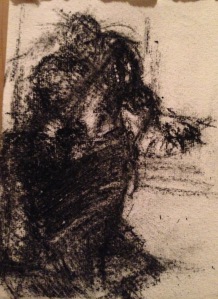After several drawings in which Christ’s figure appears and disappears simultaneously, this work represents this key moment as a landscape, in which one can only guess the face of the son of God, and a part of His torso.
Here, the extreme beauty and conundrum of the style convokes numerous references, coming both from earlier and classic Renaissance, Baroque, but also, in the 20th century, Abstract expressionism and colorfield painting, for example.
An art historian can here convokes Duccio, Giotto, then Masaccio and his Brancacci chapel.
Michelangelo is omnipresent, both from his unfinished works, but also because His ‘’Separation between earth and sky’’, on the Sistine Ceiling, is here reinterpreted with an astonishing maestria and invention.
Titian’s last paintings are exceeded in this drawing.
One thinks also of the dramatic spaces, moved beyond left figures and scenes, crossed by low-angle lights, of Caravaggio’s paintings.
Rembrandt and Rubens are transcended.
The Spanish masters of the 17th century are also present: one thinks of El Greco, Velasquez, Zurbaran (both for the elongation, which one can sense, of the face, for the pressure of space, and for the landscape this figure is, too).
Then, getting through the centuries, an art historian can think of Géricault’s, Delacroix’, Van Gogh’s drawings, Goya’s engravings, and Carpeaux’ and Rodin’s sculptures, for the immense power and dramatic intensity this work owns.
Going further, one will evoke Franz Kline, for example his ”Painting Number 2”, 1954, MoMA, Robert Motherwell, for his ‘’ Iberia”, 1958, Guggenheim Bilbao Museum, Rauschenberg, for his ”Untitled [small vertical black painting]’’, 1951, Private collection and his ‘’Untitled (Gold painting)”, 1953, Rauschenberg Foundation.
Of course, one thinks of Mark Rothko, and Jackson Pollock, all of these recent masters and their styles surpassed for the benefit of an entirely new art which reinvents the iconography, as well as the way of drawing (this work is a painting, an engraving and a sculpture both), and the extreme joy and fear an art historian feels, being the witness of the rising of such a great creator.
- Comment
- Reblog
-
Subscribe
Subscribed
Already have a WordPress.com account? Log in now.
